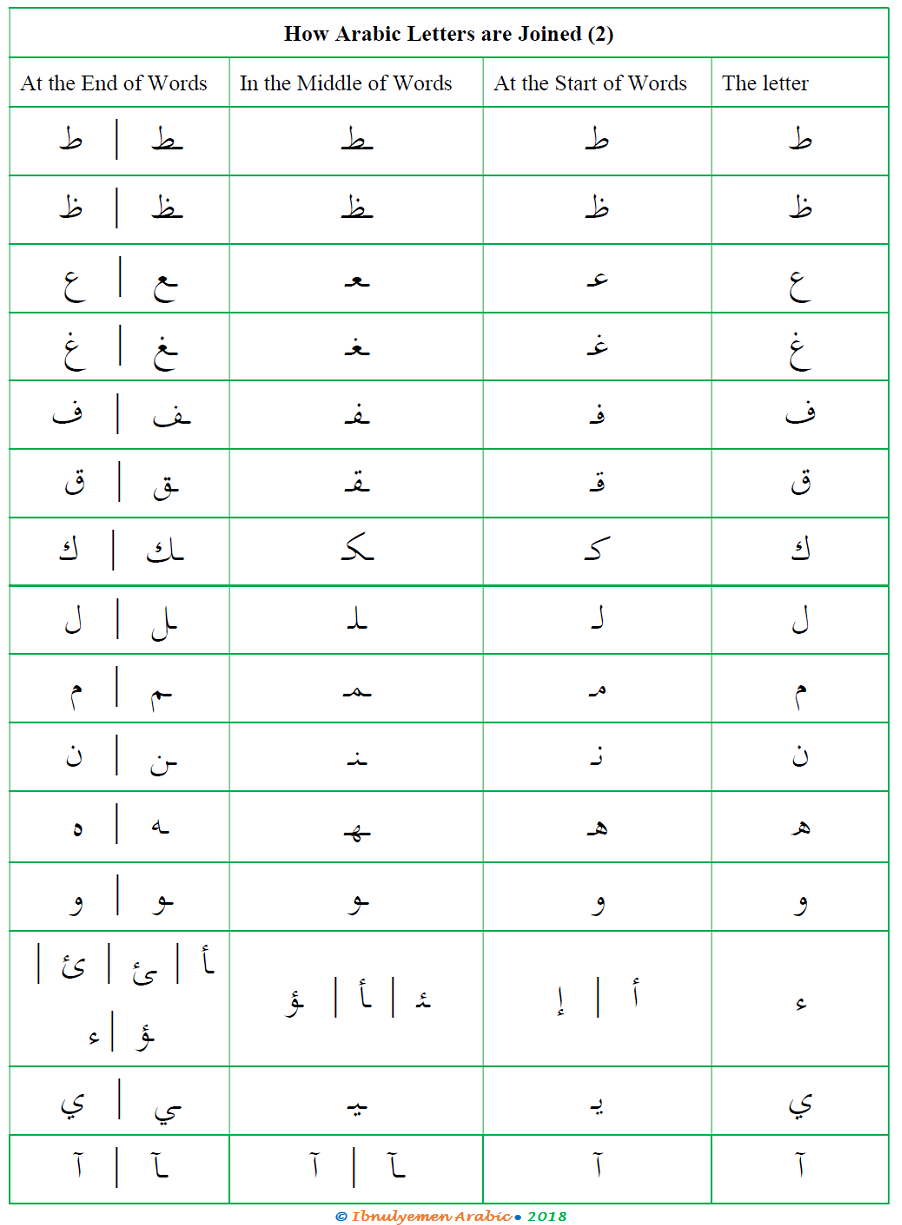Connecting Arabic letters is the focus of this lesson, namely the last fifteen letters of the alphabet. In the previous lesson, you came to know how the first fifteen Arabic letters are joined to other letters. You also learned that there are six letters that never join to letters that follow them. They are ا, د, ذ, ر, ز, and و. In this lesson you will learn how the remaining fifteen letters are joined.

In the table above, except for hazmah أ, alif madd آ, which are both similar to the alif ا in shape, and the و, all the letters at the beginning of the word connect to subsequent letters.
We write the hamzah ء on or under an alif when it occurs at the beginning of the word. We put it on the alif أ if the alif has fatHah over it; if it has kasrah below it, we put the hamzah under the alif إ. The difference between the hamzah and the alif is that short vowels (i.e. fatHah, DHammah, and kasrah) accompany the hamzah, while the alif cannot be accompanied by any of them. In other words, the alif is always saakin, that is accompanied by a sukuun ْ.
The alif madd is basically a combination of two letters. When a hamzah is followed by an alif, they are combined and written as alif madd آ, i.e. ء + ا = آ.
In the middle the word, all the letters connect to preceding letters. The Hamzah is written in three different ways: on a yaa’-like shape ـئـ, on an alif ـأ, and on waaw ـؤ. This is determined by the Harakaat. As a rule, if it is accompanied by fatHah, it is written on an alif ـأ; if it is accompanied by kasrah, it is written on dot-less yaa’-like shape; if it is accompanied by DHammah, it is written on ـؤ; and if it accompanied by fatHah and preceded by alif, it is written by itself. There are few exceptions which you will learn about in future lessons.
At the end of the word, all the letters are connected to the preceding letter. If the preceding letter is one of the six semi-joining letters, all the letters are written in isolation. Word-finally, the haa’ هـ is written like this ـه if joined the preceding letter, if not, it is written like this ه. As for the hamzah, it is written on alif, on yaa’, on waaw, or by itself. If the letter that precedes it is accompanied by fatHah, it is written on an alif; if the letter that precedes it is accompanied by DHammah, it is written on a waaw; if the letter that precedes it is accompanied by kasrah, it is written on a regular yaa’, i.e. ئ or ــئ; if the letter that precedes it is an alif, it is written in by itself.
Here are some illustrative examples:
عَـ + ـفَـ + ا + ف = عَفَاف
نُـ + ـكْـ + ـرَ + ا + ن = نُكْرَان
وُ + جُـ + ـو + ه = وُجُوه
هُـ + ـمُـ + و + مُـ + ـهُ = هُمُومُهُ
يَـ + ـبْـ + ـد + أ = يَبْدَأ
مُـ + ـفَـ + ـا + جِـ + ـئ = مُفَاجِئ
مَـ + ـسَـ + ـا + ء = مَسَاء
In the next lesson, you will learn how to transliterate Arabic letters/sounds into the corresponding English sounds.